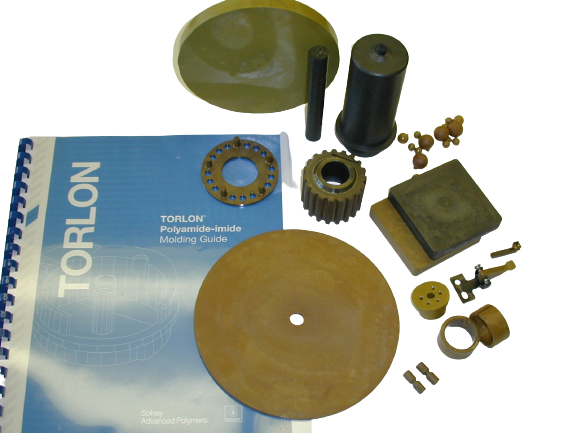Critical high-performance parts that must perform under extremely high temperatures and stress need to be made with a resin that can handle it. Torlon® PAI (polyamide-imide) is an engineering thermoset polymer that is up to the task, but there are less than 100 companies around the world that can properly convert it using injection, compression, or extrusion processes. Torlon® PAI resin requires special considerations for successful molding, and every step of the process must be exact.
Why Use Torlon® PAI
Despite processing challenges, the companies that invest in understanding the polymer, special equipment, and skills required to mold parts do it because it offers their customers an opportunity to design products that otherwise wouldn’t be possible with traditional polymers. Torlon® PAI offers a combination of properties that are invaluable for critical products in demanding conditions, such as parts for the space shuttle, automotive transmissions, and medical devices. Torlon® PAI molded parts are:
- Useful at temperatures up to 260°C (500°F)
- Exceptionally strong
- Resistant to impact
- Dimensionally stable
- Low thermal expansion coefficients
- Resistant to chemicals and radiation
- Good electrical insulator
- Resistant to flame
Processing Challenges Torlon® PAI
There are two types of polymers used in injection molding: thermoplastics and thermoset. Thermoplastics become fluid when heated and solidify when cooled. This process is reversible as no chemical bonding takes place. Unlike thermoplastics, thermoset polymers require curing. When they are cured, macromolecular chains bond in an irreversible crosslinked three-dimensional network. Torlon® PAI is a thermoset polymer, so to prevent the chain extension and crosslinking from happening during the injection molding process, a unique set of conditions and equipment controls are needed.
Torlon® PAI has a high glass transition temperature (680– 720°F), the temperature at which it becomes a viscous liquid or rubbery. In the melted phase at high shear rates, Torlon is viscoelastic — the viscosity changes, and it can become elastic when stretched or compressed. These characteristics create challenges for the injection molder, so melt-processing operations used for thermoplastic aren’t possible, and tightly controlled modifications must be made.
Another challenge with working with Torlon® PAI is that it is hygroscopic. This moisture sensitivity means it must be thoroughly dried with a moisture content of no more than 500 ppm (0.05%) and maintained at that moisture content throughout the injection molding process. It can take 8-12 hours to achieve a low enough moisture content. If the polymer absorbs ambient moisture during processing, it may foam or create other molding issues and result in brittle parts.
The parameters of the injection molding process must be tightly controlled. It can be processed using conventional screw injection molding equipment, but a low compression screw is required and the machine must be equipped with high-temperature heaters. Unlike conventional molding, the molds must be heated as well as the barrel.
The barrel size should be appropriately sized and the cycle time as short as possible to minimize residence time. Extended residence time can result in the polymer curing in the barrel and reducing flow. However, too fast of a cycle time results in issues such as sprue breakage, sticking, or warpage of the part. The injection molder must strike a balance between a too fast and too slow cycle time.
Machine selection is critical as clamp force must be adequate for the part — 4 tons of clamp pressure per square inch (620 kg/sq cm) of projected part area. If the clamp and hold pressures are too low, flash and internal voids can result.
Once the parts are molded they may look complete, but they are brittle, have poor chemical and wear resistance, and have a sub-optimal thermal resistance. Post-processing curing is a critical step for developing the optimum physical properties of the part. The curing process is closely controlled and involves placing the parts in a forced-air oven that is set to rise in temperature incrementally for specified times. It is essential that the temperature is uniform throughout the oven, with the hot spot to cold spot difference not exceeding 10°F. The curing process can take as long as 21 days.
Since the injection molding process requires special ovens, equipment modification, and tight controls, it’s no wonder not many injection molders take on the challenge. In addition, the producer of Torlon® PAI, Solvay, is serious about protecting its brand and doesn’t sell it to every processor.
Ensinger, an Approved Torlon Processor
Solvay requires that all processors of Torlon® PAI become an “Approved Molder” through its qualification process to ensure that they can meet the highest quality standards. Ensinger has met the standards required, demonstrating our knowledge of the material and the capabilities to properly mold and cure it.
At Ensinger, we understand the complexities of high-performance product manufacturing and relish taking on challenging projects. Our wide range of services, including injection molding and secondary services, engineering services, project management, and more, allow us to provide a total solution.
Do you have a high-performance molded product challenge? Contact us for assistance.
